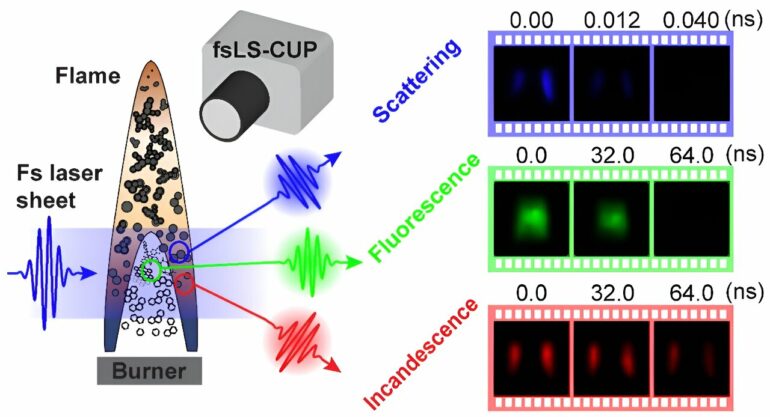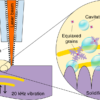Candle flames and airplane engines produce tiny soot particles from polycyclic aromatic hydrocarbons (PAHs) as their precursors, both of which are harmful to humans and the environment. These carbon-based particles are also common in space, making up 10–12% of interstellar matter, and are becoming valuable for use in electronic devices and sustainable energy. However, the fingerprint signals of soot and PAHs have very short lifespans in flames—lasting only a few billionths to millionths of a second. This brief existence requires very fast cameras to capture their behavior in both space and time.
Currently available imaging systems can capture only a few million frames per second and often require multiple laser pulses, causing unwanted heating problems. Traditional methods are also limited because they can only capture repeatable events by sequentially recording multiple images to stitch together a complete motion picture. These constraints have left researchers in combustion science eagerly awaiting a new tool to overcome these challenges.
In a new paper published in Light: Science & Applications, Dr. Yogeshwar Nath Mishra, Dr. Peng Wang, Dr. Murthy S. Gudipati, and Professor Lihong V. Wang from the California Institute of Technology, in collaboration with Dr. Florian J. Bauer from Friedrich-Alexander University Erlangen, introduce femtosecond laser sheet-compressed ultrafast photography (fsLS-CUP). This revolutionary technique, as the world’s fastest single-shot planar imaging camera, captures entire movies of femtosecond laser-flame dynamics at an unprecedented 250 billion frames per second (Gfps), making it 20,000 times faster than the existing imaging systems.
Using just a single femtosecond laser pulse, fsLS-CUP enables simultaneous, wide-field, real-time imaging of laser-induced fluorescence (LIF) from PAHs and laser-induced heating (LIH) from soot particles, along with elastic light scattering (ELS) from laser-soot interactions.
Dr. Yogeshwar Nath Mishra explained, “Scientists have used ultrafast laser pulses to capture rapid chemical reactions and laser interactions with materials in real-time. Using a femtosecond laser and a streak camera, we have developed a new 2D imaging method, fsLS-CUP, that can capture some extremely fast phenomena in nature.
“Ultimately, it has not only advanced our understanding of hydrocarbon and nanoparticle formation and growth in flames but also holds potential across multiple fields, making it a significant milestone in ultrafast imaging technology. Our research, which includes the fastest observation of PAHs, complements NASA’s mission to explore the origins of life and cosmic evolution. Beyond combustion research, this technique has broad applications in physics, chemistry, biology, medicine, energy, and environmental science.”
Dr. Peng Wang emphasized that their work marks a significant advancement in ultrafast imaging and science, with the potential to unlock rapid phenomena crucial to natural science and technology. The team continues to push boundaries in imaging performance, including speed, spatial resolution, and image reconstruction fidelity.
They have successfully applied real-time imaging to observe laser-induced signals from soot and PAHs in combustion. Wang believes that ongoing innovation and collaboration will lead to further discoveries and understanding in this field. Overall, fsLS-CUP opens new possibilities for studying transient phenomena in a planar configuration.
Dr. Florian Bauer highlighted that the fsLS-CUP technique acquires data in a single shot using just one femtosecond laser pulse, leveraging compressed sensing. The method offers a wide field of view and resolves both spatial and temporal details, making it adaptable for observing various femtosecond laser-induced signals in PAHs and carbon nanoparticles. It has successfully extracted crucial details like the 2D distribution of fluorescence lifetimes of PAH molecules. The technique also confirmed that femtosecond laser pulses can induce incandescence in soot particles.
Dr. Murthy S. Gudipati, an expert in PAH astrochemistry, stated, “PAHs are robust molecules in interstellar space. Understanding the formation of PAHs and carbon soot expands our knowledge about their existence under astrophysical conditions as well.
“Our study is relevant to PAH formation in hot environments, such as carbon-rich asymptotic giant branch stars. These evolved stars have hot atmospheres and strong stellar winds, creating ideal conditions for PAH formation. Additionally, the hot, expanding ejecta of supernova explosions provide another environment where PAHs could potentially form at high temperatures.”
More information:
Yogeshwar Nath Mishra et al, Single-pulse ultrafast real-time simultaneous planar imaging of femtosecond laser-nanoparticle dynamics in flames, Light: Science & Applications (2024). DOI: 10.1038/s41377-024-01588-x
Provided by
Chinese Academy of Sciences
Citation:
The world’s fastest single-shot 2D imaging technique films ultrafast dynamics in flames (2024, September 3)



